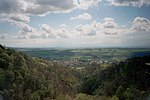Battle of Dollar

The Battle of Dollar was fought in 875 at Dollar, Scotland, between Viking invaders under Halfdan Ragnarsson and the defenders led by King Constantine I. The Vikings had previously been part of the Great Heathen Army which had been assaulting the Anglo-Saxon kingdoms of England before moving to a base by the river Tyne to raid the lands of the Picts and Strathclyde Britons. The battle ended in victory for the Vikings who occupied the east-central lowlands of Scotland for a year before settling in Northumbria. Constantine was forced back to the highlands of Atholl and would later die in a further battle with the Vikings in 876. The Picts disappear from the record after the devastation of 875–878.
Excerpt from the Wikipedia article Battle of Dollar (License: CC BY-SA 3.0, Authors, Images).Battle of Dollar
Dewar Street,
Geographical coordinates (GPS) Address Nearby Places Show on map
Geographical coordinates (GPS)
| Latitude | Longitude |
|---|---|
| N 56.161944444444 ° | E -3.6738888888889 ° |
Address
Dewar Street
Dewar Street
FK14 7DL
Scotland, United Kingdom
Open on Google Maps









